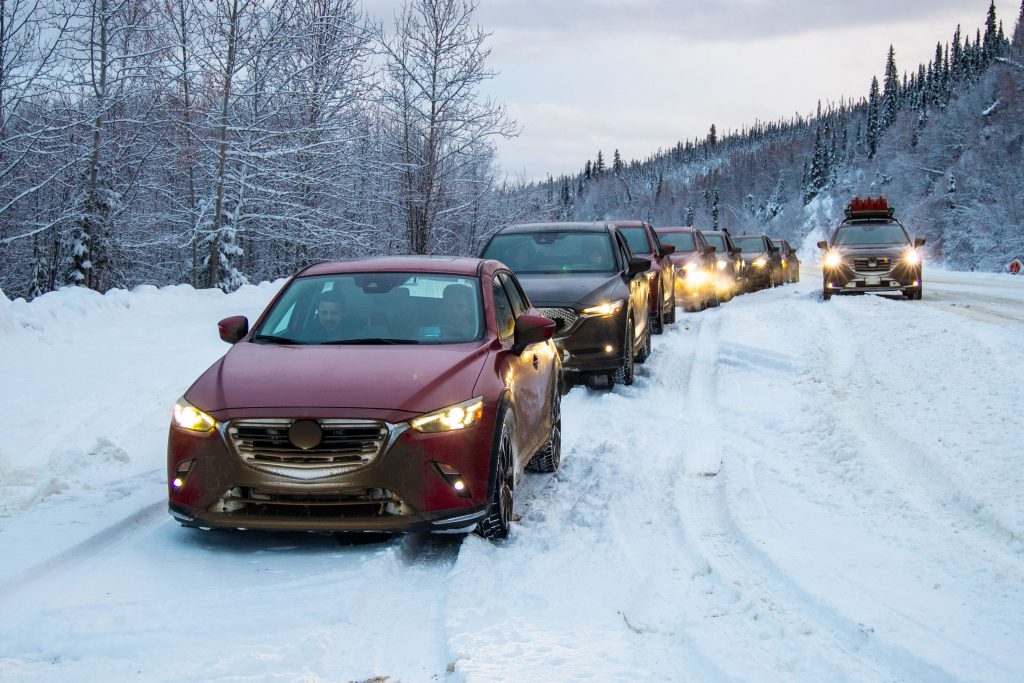Driving to the Arctic Circle in Mazda SUVs
Conquering threatening terrain and a race against time to experience this remote corner of the world

A car in our caravan of Mazdas careened into a snow drift, the sun wouldn’t emerge for another 30 days, and we were still hours from Inuvik—the last Canadian city before the banks of the world’s northernmost ocean. Welcome to the Arctic Circle. Temperature: -22 Fahrenheit.
The Mazda CX-5 SUV, wedged face-first in the pristine snow, cuts a cartoonish figure against a peaceful backdrop of sugar-dusted fir trees and white sky. The noiseless expanse before us is so picture-perfect that it almost looks fake. But once the CX-5, buried up to its axles, is finally towed from the drift, the real problems begin. We have just four miles of gas and four minutes to spare before the gates to the Arctic Circle close for the day—separating us from Inuvik and leaving us stranded with our band of Mazda SUVs until the next afternoon.

“Two kilometers away,” Derek Drake, our expedition leader, says from the driver’s seat next to me. “Four miles left. Carry the one… We should get there just in time.” Caravan Palace, the French electro-swing band, play jauntily from the stereo of our small CX-3—turning us into comic strip protagonists as powdered sugar snow swirls off the tires.
Keeping a steady clip, we race along the white-blanketed Dempster Highway, which connects the Yukon to the Northern Territories, until we roll into Eagle Plains. This is the last stop before Inuvik. “On this epic stretch of highway, being prepared pays off,” the official website warns. “Chat with those coming from the direction you’re headed and swap notes on the current road conditions.”

The walkie-talkie (our lifeline to the rest of the caravan) crackles with the voice of Danny Kok, the pro-driver leading the pack. “Make the fastest NASCAR-style pit-stop possible because once we’re out of the gate, there’s no stopping,” Kok says. “On the other side of the gate is all the cool stuff.”
Tanks replenished, we pass through the gates with minutes to spare. At 2PM, the sun is already low in the sky. “Next stop: Arctic Circle,” Kok announces over the radio—as another driver slides off the road.

Five days after setting out from Fort St. John in British Columbia, our parade of SUVs is so filthy it’s difficult to discern their make, model or color. Mazda invited us—along with a handful of other others—to the treacherous land to prove that you don’t need a giant pick-up truck to make the 1,700-mile trip through the wilderness to the Arctic Ocean. (In fact, Daimler completed part of the route in smart cars nine years ago.) Kok’s expertise and Mazda’s predictive i-ACTIV All-Wheel Drive system would help us during the weeklong drive to our destination of Tuktoyaktuk, a village on the banks of the Arctic.
Each day, we set out by 7AM, giving us three hours on the road before sunrise. As the week progresses, we pass fewer and fewer signs of life, as we drive further into Canada’s polar night—a 30-day period of darkness in which the sun doesn’t crest the horizon. Meanwhile, all 10 cars in our caravan sport windshields that appear almost bullet-ridden, due to the Dempster’s gravel base, compromising our visibility and creating the sense that we’re under constant siege.

In this manner, we drive for 10 to 12 hours each day, wending through fantastical landscapes—from old mining towns to the Drunken Forest, so-called for its tilted, permafrost-ridden trees. Eventually, we reach the final leg of our journey, the new Inuvik-Tuktoyaktuk Highway. Opened a year ago, the 85-mile offshoot of the Dempster Highway serves as the first all-weather road to Canada’s Arctic Coast and allows drivers to reach Tuk year-round.
This is not a drive that many people have made.
About 24 hours and many miles after frantically passing through the gate at Eagle Plains, we reach the edge of the continent, pulling up next to a blue-and-white sign that announces we have finally made it to the Arctic Ocean.

We park on the banks, jump out of the Mazdas and gingerly walk onto the frozen ocean—our boots sinking into snow knee-deep with each step. Once confident that the ice would not give way beneath us, we skip, jump and slide across the frozen sheet for hours. On occasion, somebody would be still; marveling at this place, in a remote corner of the planet.
The SUVs did a valiant job of getting us there, but some journeys are best finished by foot.
Images courtesy of Davey G. Johnson












